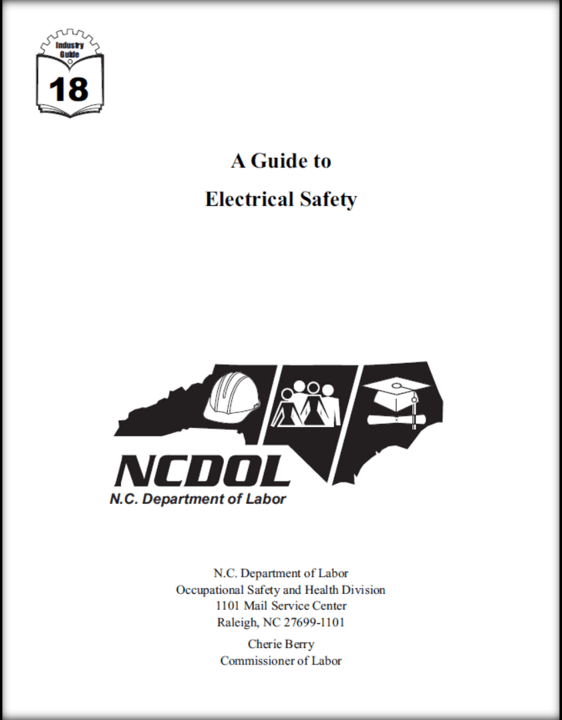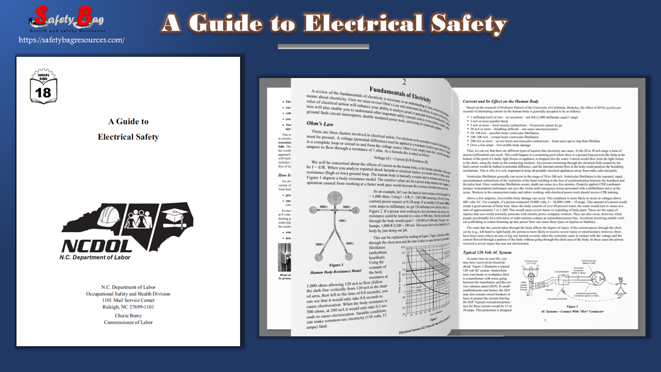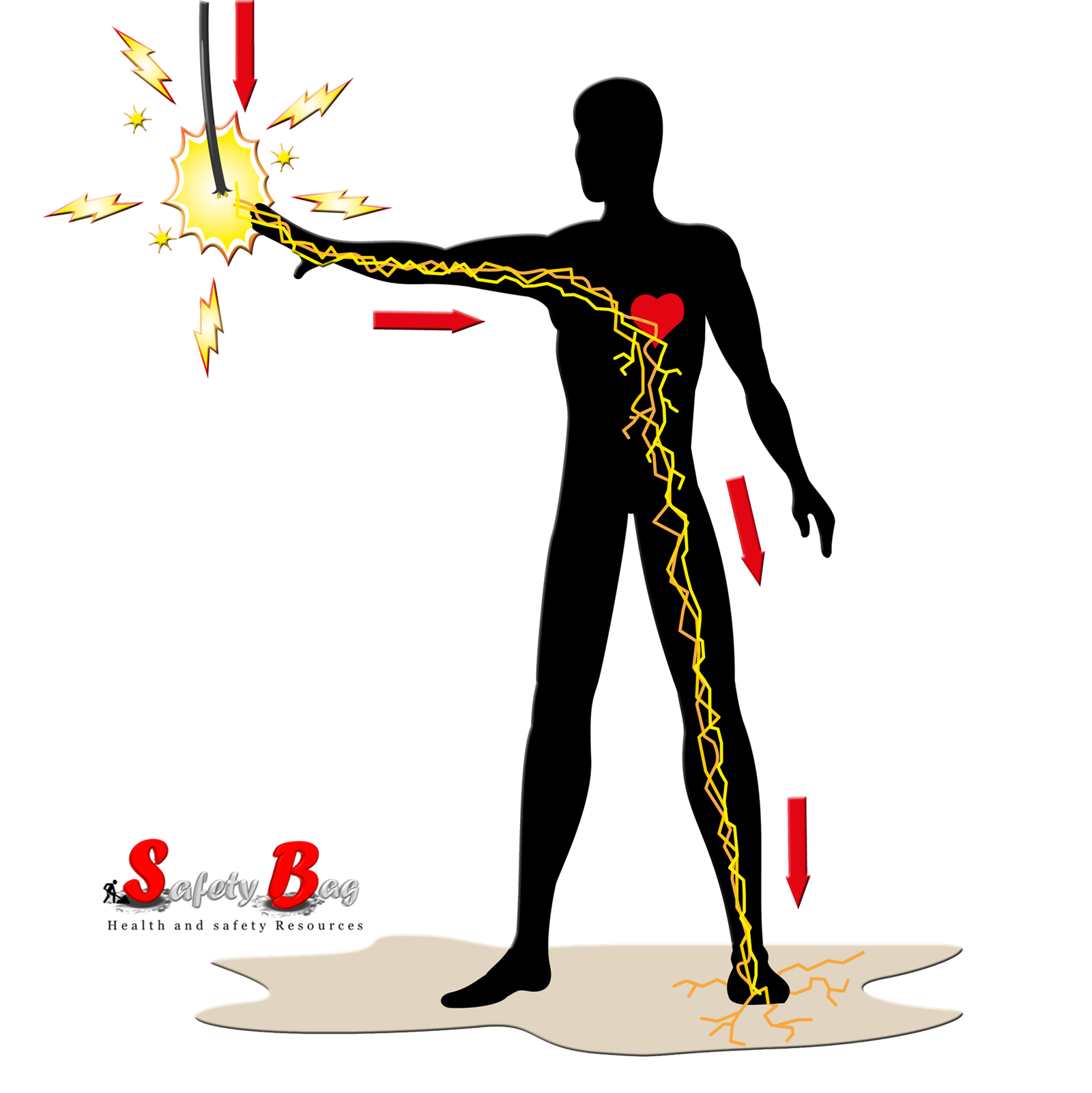
A Guide to Electrical Safety was prepared by Ed Mendenhall of Mendenhall Technical Services with additional materials provided by N.C. Department of Labor employee Dwight Grimes. The information in this guide was updated in 2012.
This guide is intended to be consistent with all existing OSHA standards; therefore, if an area is considered by the reader to be inconsistent with a standard, then the OSHA standard should be followed. Everyone from office clerks to farmers work around electricity on a daily basis. Our world is filled with overhead power lines, extension cords, electronic equipment, outlets, and switches. Our access to electricity has become so common that we tend to take our safety for granted. We forget that one frayed power cord or a puddle of water on the floor can take us right into the electrical danger zone.
A Guide to Electrical Safety can help electricians, plant maintenance personnel and many others review safe procedures for electrical work. It also covers the main U.S. Occupational Safety and Health Administration standards concerning electrical safety on the job.
In North Carolina, state inspectors enforce federal laws through a state plan approved by the U.S. Department of Labor. The N.C. Department of Labor is charged with this mission. NCDOL enforces all current OSHA standards. It offers many educational programs to the public and produces publications, including this guide, to help inform people about their rights and responsibilities.
This guide has been developed to assist an unqualified employee, one who does not have the training, skills, and technical knowledge of electrical safety. When reading this guide, please remember the NCDOL mission is greater than the enforcement of regulations. An equally important goal is to help citizens find ways to create safer workplaces. A Guide to Electrical Safety can help you make and keep your workplace free of dangerous electrical hazards.
Read the book: A guide to Electrical Safety by Flipping the file below:
Electricity is the modern version of the genie in Aladdin’s lamp. When electricity is safely contained in an insulated conductor, we normally cannot see, smell, taste, feel or hear it. It powers an endless list of laborsaving appliances and life-enhancing and support systems that have become such an assumed part of our lives that we give little thought to its
potential for causing harm. Many myths and misstatements about electrical action are accepted as fact by many people.
The National Institute for Occupational Safety and Health (NIOSH) conducted a study of workplace electrocutions that revealed the following information about workers who were electrocuted:
- The average age was 32.
- 81 percent had a high school education.
- 56 percent were married.
- 40 percent had less than one year of experience on the job to which they were assigned at the time of the fatal accident.
- 96 percent of the victims had some type of safety training, according to their employers.
This information reminds us that more effective training and education must be provided to employees if we are to reduce workplace electrocution hazards. Employees should receive initial training and then refresher electrical hazard recognition training on an annual basis.
Also Watch Video: Employee safety in confined spaces
In addition to the shock and electrocution hazards, electricity can also cause fires and explosions. According to the U.S. Consumer Product Safety Commission, an estimated 169,000 house fires of electrical origin occur each year, claiming 1,100 lives and injuring 5,600 people. Property losses from fires begun by electricity are estimated at $1.1 billion each year. The safe use and maintenance of electrical equipment at work (and at home) will help prevent fire and physical injury.
This guide provides a clear understanding of electrical action and its control in the workplace environment. This information will enable you to recognize electrical hazards in the workplace as well as provide information on their control and/or elimination. The guide does not qualify a person to work on or near exposed energized parts. Training requirements for “qualified” persons (those permitted to work on or near exposed energized parts) are detailed in 29 CFR 1910.332(b)(3). Also, 29 CFR 1910.399, Definitions Applicable to Subpart S gives a definition of “qualified person.” The guide will, however, enhance your ability to find and report electrical deficiencies in need of a qualified person’s attention.
Also Read: Electric Shock and its Psychological Effects
The Content of the Guide to Electrical Safety:
- Foreword . . . . . . . . . . . . . . . . . . . . . . . . . . . . . . . . . . . . . . . . . . . . . . . .1iiv
- 1 Introduction . . . . . . . . . . . . . . . . . . . . . . . . . . . . . . . . . . . . . . . . . . . . . . .ivi1
- 2 Fundamentals of Electricity . . . . . . . . . . . . . . . . . . . . . . . . . . . . . . . ii14
- 3 Arc Flash/NFPA 70E . . . . . . . . . . . . . . . . . . . . . . . . . . . . . . . . . . . ii11
- 4 Branch Circuit Wiring . . . . . . . . . . . . . . . . . . . . . . . . . . . . . . . . . . ii15
- 5 Branch Circuit and Equipment Testing . . . . . . . . . . . . . . . . . . . . . . . . . ii23
- 6 Voltage Detector Testing . . . . . . . . . . . . . . . . . . . . . . . . . . . . . . . . . ii26
- 7 Ground Fault Circuit Interrupters . . . . . . . . . . . . . . . . . . . . . . . . . . . . ii28
- 8 Common Electrical Deficiencies . . . . . . . . . . . . . . . . . . . . . . . . . . . . ii45
- 9 Inspection Guidelines/Checklist . . . . . . . . . . . . . . . . . . . . . . . . . . . . . ii59
- 10 Safety Program Policy and Procedures . . . . . . . . . . . . . . . . . . . . . . . . . ii61
( Also Read : Books: CAL/OSHA Pocket Guide for Construction Industry )
Download The Book
A Guide to Electrical Safety
More Downloads
- Books: How to Plan for Workplace Emergencies and Evacuation
- Books: Firefighting Precautions at Facilities with Combustible Dust
- Books: A Guide to Electrical Safety
- Books: Preventing Falls in Scaffolding Operations
- Handbook: Worker’s Safety
- Books: A Guide to Safety in Confined Spaces
- Books: OSHA-Hazard communication for small Entity
- Books: OSHA-Permit Required Confined Spaces
- OSHA: Underground Construction (Tunneling)
- OSHA Recommended Practice of Health and Safety programs in construction
- Books: OSHA-Is it Safe to Enter Confined Space?
- Books: General Industry Digest
- Books: A Guide to Bloodborne Pathogens in the workplace
- Books: 5-Minute Workplace Safety Talks
- CAL/OSHA Scaffold Guide for safe use of supported Scaffolds
- Books: CAL/OSHA Pocket Guide for Construction Industry
- Books: Let’s Talk Safety
- Books: OSHA Fall Protection Toolbox Talks and Trainer Guide


